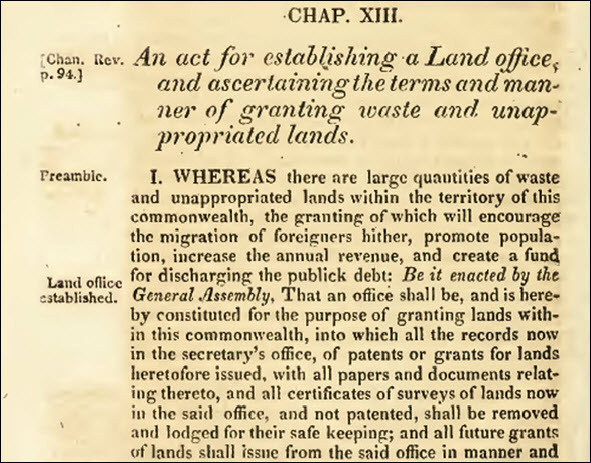The Fairfax grants
Reader Kathi Jacobs discovered that an ancestor received two land grants in early Virginia that had some language in the documents she wasn’t quite sure of.
“My 6x great grandfather George Edgington obtained land grants from Thomas Lord Fairfax, one in 1777 and two in 1779, for land in Hampshire County, Virginia in The Northern Neck of Virginia,” she wrote. “Each grant states that it is for ‘a certain tract of waste and ungranted land.’”
So, she wanted to know: “Is there some special meaning to this language?”
To which The Legal Genealogist can only respond: Well, yes… and no.
How’s that for a good lawyer-like answer?
It does have a specific meaning in context. But it doesn’t mean the land is bad or second-rate or worthless.

Let’s back up a little bit and look at the history of the Fairfax land grants in early Virginia.
Remember that in the mid-1600s, the English crown was pretty much up for grabs. The English Civil War had resulted in the execution of Charles I in 1649, and his son Charles II was then in exile.1 To win support and reward his allies, Charles II issued a royal grant for more than five million acres in northern Virginia to seven allies — one of whom was Lord Fairfax. “By 1688 most of the region was owned by Thomas, Lord Culpeper. Lord Culpeper’s daughter married Thomas, Lord Fairfax, in 1690, and the region became synonymous with the Fairfax name.”2
And the result was that land within that territory was sold off — patented — by Fairfax to individual owners. These are called the Northern Neck, or Fairfax, grants.3
In 1736, the Virginia Assembly first addressed the issue of the Fairfax grants because of inconsistencies in royal patents issues by Charles II and James II, and it directed that “all and every grant and grants, heretofore duly and regularly made and passed by any of the agents or attornies of the proprietors of the said territory, or any of them, shall be good, available, and binding in law, to pass such estate or estates as therein have been granted; and the grantees, their heirs and assigns, respectively, shall for ever hereafter peaceably and quietly have, hold, and enjoy the same granted premises, according to such granted estates…”4
By 1748, the Virginia Assembly had addressed the issue of the Fairfax grants because of inconsistencies in royal patents issues by Charles II and James II, and those who’d received grants were confirmed in their lands any “mis-recital or defect in the said grants notwithstanding.”5
Then after the Revolution, in May 1779, the Virginia Assembly again addressed the issue when it set up its own land office, and it then provided, as to lands subject to the royal grants, that “all lands thereby respectively granted, shall be held in absolute and unconditional property to all intents and purposes whatsoever, in the same manner with the lands hereafter to be granted by the commonwealth by virtue of this act…”6
Even the U.S. Supreme Court got into the act in 1812, in when a dispute arose over the inheritance of Fairfax’s land rights by a relative who was a British citizen who’d never lived in America, and that Court said the land rights continued in the Fairfax family.7
But think for a minute about what it was Fairfax — or any land owner — can transfer or grant to another person. He (or the government or a land office or whoever) can only grant to person A land or parcels that haven’t already been granted to person B.
So… how do you describe the land that’s available to be granted? Land that hasn’t already been granted to someone else?
You describe it, if you’re Lord Fairfax, as “waste and ungranted land.”
Or, if you’re the Virginia General Assembly in 1779, as “waste and unappropriated lands.”8
In other words, not bad or worthless or second-rate lands. Not a wasteland as we’d think of that term today. But just lands that hadn’t yet been granted to someone else.
Great question, Kathi!
SOURCES
- See Wikipedia (http://www.wikipedia.com), “Charles II of England,” rev. 11 Oct 2018. ↩
- “About the Virginia Land Office Patents and Grants/Northern Neck Grant and Surveys: Northern Neck Land Office,” Guides, Library of Virginia (http://www.lva.virginia.gov/ : accessed 14 Oct 2018). ↩
- Ibid. ↩
- An Act for confirming and better securing the Titles to Lands, in the Northern-Neck, held under the Right Honorable Thomas Lord Fairfax, Baron of Cameron, in that part of Great-Britain, called Scotland, Chapter XIII, Laws of Virginia August 1736, in William Waller Hening, The Statutes at Large … of Virginia… (Richmond: p.p., 1820), 4: 514, 522-523. ↩
- “An Act for confirming the grants made by his majesty, within the bounds of the Northern-Neck, as they are now established,” Chapter LV, Laws of Virginia October 1748, in Hening, The Statutes at Large … of Virginia… (Richmond: p.p., 1819), 6: 198-199. ↩
- “An act for establishing a Land office, and ascertaining the terms and manner of granting waste and unappropriated lands,” Chapter XIII, Laws of Virginia May 1799, in Hening, The Statutes at Large … of Virginia… (Richmond: p.p., 1822), 10: 50 et seq. ↩
- Fairfax’s Devisee v. Hunter’s Lessee, 11 U.S. 603 (1812). ↩
- Chapter XIII, Laws of Virginia May 1799. ↩



Thank you for clearing up the confusion regarding this terminology.